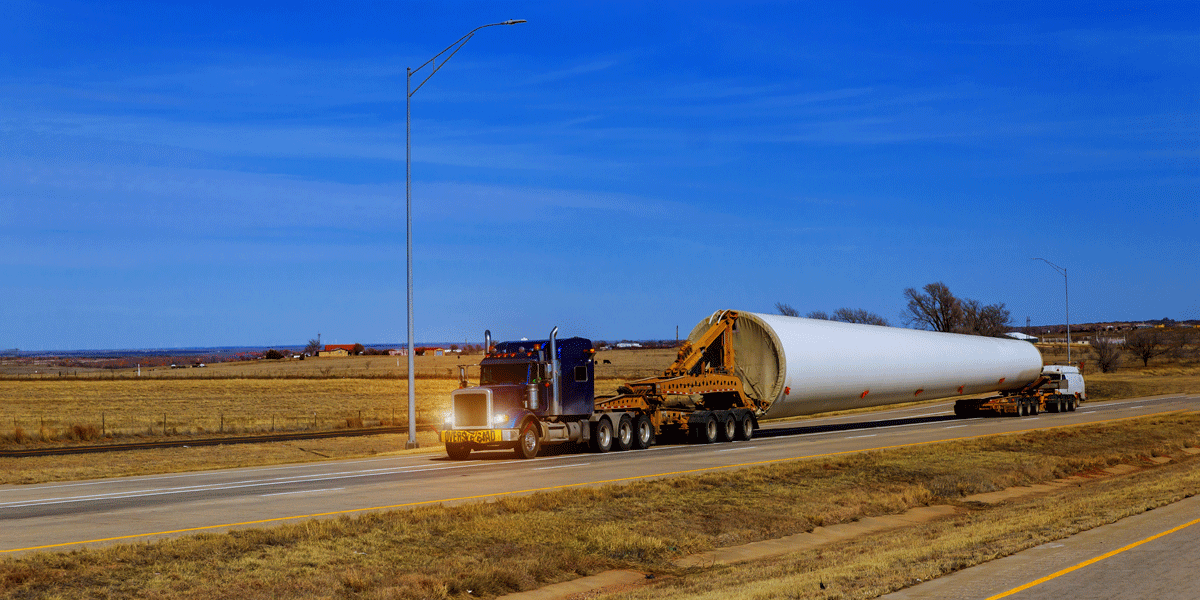Everything Truck Drivers Should Know About Oversized Load Permits
Joanna Jungels began her career with ATS in 2005 as a fleet manager. Soon after, she was promoted to oversee and enhance a growing OS/OW permitting team which created a system to retain and output rules and requirements for both state and local entities. Today, Joanna regularly attends state transportation meetings and currently serves as chair of the Permit Policy Committee at the Specialized Carriers & Rigging Association, where she advocates for, and promotes the importance of, creating useful resources to better understand and increase awareness around the complexities of oversized freight. In her role at ATS, Joanna enjoys working with others to brainstorm, solve problems, and learn new things while continually striving to improve the processes and resources available to ATS' customers.
When you’re moving into hauling oversized freight, the rules change. Suddenly, you’re working with bigger dimensions, stricter regulations, and a whole new set of requirements to follow.
At the heart of it all is one key element: oversized load permits. These permits dictate where, when, and how you can move your freight, ensuring that everyone on the road stays safe and that roadways and infrastructure aren’t damaged.
As the over-dimensional permits manager at Anderson Trucking Service (ATS), my team is immersed in permitting every day. Our job is to secure the necessary permits for the oversized freight our drivers haul and guide them through the sometimes confusing and high-stakes world of permitting.
Thankfully, ATS has our in-house permitting team — a resource that not every company provides — and I’m here to pass on some of the knowledge we’ve built up.
These guidelines will cover everything you need to know about oversized load permits, including why you need them, what’s included in them, how to read and follow them, and the process for securing them. Whether you’re hauling for a company or running your own operation, this is your roadmap to navigating the permitting process successfully.
- Why you need an oversized load permit
- What’s included in a permit
- How to read/follow a permit
- How to get permits
- The importance of following permits
Why Do I Need an Oversized Load Permit?
Oversized loads need permission to travel. If the load being hauled is over legal set dimensions in any category, the load isn’t considered legal and the driver needs to get permission to travel those roads. This permission comes in the form of an oversized permit.
Permits are highly specific, stating how you can travel, when, what time, where, with who, and with what type of freight in which dimensions. Permits may dictate what you need on your truck like lights or flags and whether or not you need pilot cars and police escorts.
If you don’t follow the permit to a T, there are repercussions (more on that below).
Legal dimension limits vary by each state. Requirements for oversize permits by state, country, city, and township levels depend on whoever owns the road.
This makes permitting particularly difficult, and, quite honestly, confusing — especially for drivers hauling freight across multiple states. Separate permits need to be secured for each leg of the journey.
A load can be over-length, over-width, over-height, and/or overweight. Any load that’s not legal — whether it’s too big or too heavy — is referred to as either oversized (OS), overweight (OW), or over-dimensional (OD). Each state refers to it differently.

What’s Included in a Permit?
Permits are in place for a few reasons, including to ensure roadway infrastructure is protected, the motoring public is safe, and the driver (and freight) is safe.
For example, some oversized freight can’t move on certain days (like holidays), during rush hour, and at night. This is because oversized freight can be a hazard to the motoring public, so it’s best for the freight to move when there are fewer vehicles on the roadways.
Permits also require drivers to follow a specific route. This is so drivers can avoid damaging roadways and other infrastructure they’re too big to be on.
Some bridges have low weight restrictions or they’re susceptible to bridge hits. Low shoulders or sharp turns can also be a problem for oversized loads. If there’s construction, the load could be too large to safely maneuver through the work zone.
How to Read and Follow Oversized Permits
Understanding how to read permits is of the utmost importance for drivers. Failing to do so can result in bridge hits, accidents, fines, moving violations, and more.
Some companies — ATS being one of them — have a formal process that drivers need to follow to make sure they’re following permitting rules.
At ATS, we also have a checklist for drivers new to hauling oversized freight.
These tips will help you understand your permit and help ensure you’re running safely:
Read the Permit
Read your permit and work through it to understand what it’s saying. If there are any special attachments/provisions that go along with it, make sure you read those. You may need to refer to a permit book or a government website for further provision details.
Ensure All the Details Match
Before you leave the shipper, measure, measure, measure. It’s important to double-check your load’s dimensions and make sure they match exactly what’s on the permit. If your permit says one thing and your load doesn’t match those dimensions, you’re essentially driving without a permit. If caught, you’ll be treated as such.
While you’re at it, double-check to make sure the permit matches your truck and load. Verify the following:
- Trailer details (length, license, VIN, year make)
- Permit dates
- Truck details (license, VIN, year, make)
- Travel Restrictions (daylight, curfews, nighttime, weekends, holidays)
- Travel Requirements (flags, signs, lights, pilot vehicles)
- Additional Requirements (speed limit, calls required, patrol, attachments/provisions, signature required)
If any information doesn’t match, or if you overlook a requirement you’re in violation of your permit.
Ask Questions
Any questions that may arise after reading your permits shouldn’t be left on the table; you need to talk to your driver manager (DM) or dispatcher about your questions. If they don’t know the answer, they’ll know who to talk to to get more information.
Follow Your Checklist
If your company has a checklist to follow, go through every part of it before you leave the shipper and while you’re on route.
Review the Route
Following the permitted route is of particular importance. Failure to do so, as you know by now, can result in disastrous consequences. Ensure your route makes sense and that you can follow it without deviating. The permit doesn’t serve its purpose if it isn’t followed.
Trip Plan
After reviewing everything, make your trip plan — fitting in stops for fueling, taking breaks, and parking as needed. Again, you always need to make sure you’re staying on permitted roads.
Check the weather to ensure there aren’t any weather patterns that will prevent you from moving.
As you’re planning, make sure your Hours of Service (HOS) and permit curfews are top of mind.

How to Get Permits for Your Oversized Loads
Depending on the company you’re driving for, getting a permit for your oversized load is as simple as calling your permitting department and having them order a permit for you. Some companies have in-house permit departments and some don’t. ATS does have an in-house permit team. Hello, that’s my team!
When a driver gets assigned an oversized load, we get to work ordering the permit for them. That consists of determining the load size and plotting out a route the load can safely travel on. Finding a route can be a bit like putting together a puzzle.
Once the permit is submitted, it can take some time for it to get approved. Some states have an automatic approval process and others can take days or weeks. It all depends on how big the load is and where it’s going.
The same can be said for the price of permits. Again, it ranges based on the size of the freight. Some companies pay for their drivers’ oversized load permits and others don’t. Many companies charge the customer for the permit.
If you’re running for yourself or your company doesn’t have an in-house permit team, you’ll have to go through a permit service or order the permits yourself.
Once the permit is approved and obtained, it needs to be sent to the driver where it’s accessible in the cab either electronically or as a physical copy. Whether you need an electronic or physical copy of the permit depends on what the state or locals allow.
The Importance of Following Oversized Permits
The reason permits are needed for oversized freight is to protect the motoring public and infrastructure. If you don’t follow those permits, you’re not protecting those things. There are major repercussions for that.
Remember when I said finding a suitable route for an oversized load is a bit like putting together a puzzle? Well, if drivers don’t follow that route, it can result in hitting bridges, getting stuck on train tracks or narrow roads, and getting into catastrophic accidents — all of which can tie up the roadways and stop traffic for hours. There’s a reason you can only drive on certain roads with oversized loads.
If you’re off-route and an accident occurs — even if it wasn’t your fault — you’ll be to blame because you weren’t supposed to be on that roadway at all. If you haven’t guessed by now, permitting is very serious.
Getting caught off-route or not following your permit can result in legal consequences as well. If your load doesn’t match your permit, you’ve violated a curfew, or you’ve otherwise violated your permit, you’ll have to pull over or be escorted to a safe area until the permit issue is resolved.
Some jurisdictions will tow the tractor and trailer until a permit is secured — which can take days and result in hefty fees in time and money.
As a driver, you’ll receive a moving violation that results in Compliance, Safety, and Accountability (CSA) points that will go against your company’s safety score. Civil penalties can be handed out and some states can suspend or revoke your ability to obtain permits. As a result, you or your company may lose valuable customers until you can haul freight in that area again.
That’s why it’s important to not only make sure your permit is correct but to also make sure you’re following it closely. If you notice you missed your exit and you’re not sure if you’re on the right road, stop and call your dispatcher. They’ll help you figure out if you can either get a new permit from your location or if you need to contact authorities to get you safely back on route.
Stay Safe Year-Round
Navigating oversized load permitting is no small task, but with the right knowledge and tools, it’s manageable and can lead to a rewarding path hauling oversized freight.
Permits are your roadmap for safe, compliant, and efficient transport, protecting both public safety and valuable infrastructure. By following these guidelines, from securing accurate permits to planning your route, you’re ensuring each job goes smoothly and avoiding the costly consequences of non-compliance.
Remember, whether you're driving for a company with a dedicated permit team or handling permits independently, the stakes are high, and getting it right matters. Stay prepared, check your details, and don’t hesitate to ask questions.
Your commitment to compliance not only keeps you and the public safe, but it builds trust with your company and clients alike. So, keep these permit guidelines in mind, and haul safely out there!
If you’re looking for more safety tips that will help you stay safe all season long, check out and subscribe to the Learning Center.


